Johnny A: “I love vintage guitars and amps, but I love new ones, too. The bottom line is: does it sound good?”
We join the mercurial Massachusetts guitar legend to talk gear, playing with the Yardbirds and what the future holds...
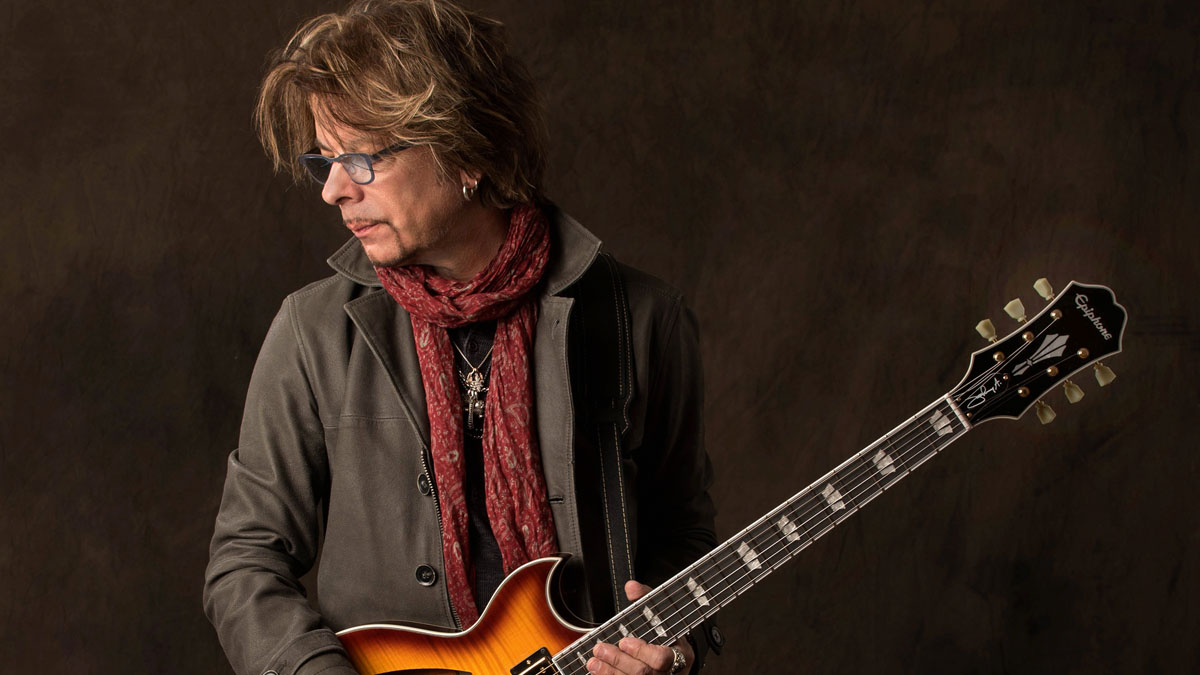
“I was a huge fan of The Yardbirds when I was a kid. They were my second favourite band behind The Beatles, and it is a great honour to be part of that legacy,” Johnny A. tells us. Having filled some of the biggest shoes in rock ’n’ roll history, however, he’s now treading his own path with a standalone solo show.
“It was great to fulfil the experience of playing music under the moniker of a band that influenced me so much as a kid,” he says. “I had a great time doing it, but I’ve been out of The Yardbirds since 2018. That’s when I started doing the solo shows. The completely solo shows. It was a huge undertaking to get that going. And it was a strange time for me.”
How did The Yardbirds gig come about?
“I had met them previously, because we were both on Steve Vai’s label [Favored Nations] and had albums coming out at the same time. When they played Boston at the original House Of Blues, I went along and introduced myself and they asked me to sit in, which I did.
“I had a great time. We crossed paths over the years since then and the opportunity eventually came when Jim [McCarty] was reforming the band. He was looking for guys in the States and Steve Vai recommended me for the gig.
“Initially, I couldn’t do it as I was already committed to a tour, but when their tour got cancelled, they rescheduled and called me again. It worked out well, and I ended up working with them for close to four years.”
How soon did things fall into place with The Yardbirds’ new line-up?
Get The Pick Newsletter
All the latest guitar news, interviews, lessons, reviews, deals and more, direct to your inbox!
“We got a song list, rehearsed for a day and a half, and just went out and did about 25 shows in a month! It was a lot of fun. It was a really good line-up.
“It was very authentic-sounding and feeling, because the three guys that came into the band at the same time – myself, [harmonica player] Myke Scavone, who plays in a New Jersey garage band called The Doughboys, and Kenny Aaronson on bass – were all very much steeped in that early Yardbirds stuff.
“We really had an understanding of where that music came from. I think there’s a certain feeling of the era that helps in understanding how to make that band click.”
When I saw The Beatles on 9 February [1964] on The Ed Sullivan Show, it completely changed the whole trajectory of who I wanted to be
Presumably, being a fan of The Yardbirds stood you in good stead…
“I was such a huge fan. The ’65/’66 version of the band with Jeff Beck was really, really influential to me as far as approaching the way I played rock blues guitar goes. There are different influences for me with the different things that I do, but as far as rock blues guitar goes, I would say The Yardbirds are extremely inspirational and influential.”
When did you begin playing music?
“I started playing music when I was six. I was a drummer. I was into jazz guys like Sandy Nelson and Gene Krupa and Buddy Rich. But when I saw The Beatles on 9 February [1964] on The Ed Sullivan Show, it completely changed the whole trajectory of who I wanted to be.
“I just heard all that melody and suddenly I wasn’t interested in playing drums any more. I begged my mother for a guitar, and she bought me a $49 electric guitar with a tiny little amp. I didn’t even know how to tune the thing. It was a Lafayette [Radio] Electronics, which was like a RadioShack type of place.”
Why did your time with The Yardbirds come to an end in 2018?
“I had been doing a solo thing for many years prior to The Yardbirds. I think it’s important to be creatively progressive and try to go forwards. I have a career as a songwriter, and I want to be progressive and current.
“So my band thing and The Yardbirds ended up dovetailing me into the solo project that I’m doing now – the completely solo shows. This project is about playing music that influenced me growing up. I’m not doing any of my own songs – there are none of my own compositions in the show.”
How do you find performing alone?
“It’s emotionally challenging and it’s physically challenging, because it’s solo guitar with looping, which takes a shitload of concentration. But when it works and it’s smooth and I’m relaxed, it’s fun. Then there’s nothing like it. It feels really intimate with the audience. It’s a very communal feeling, like we’re all in this together. There are a lot of stories about the songs that influenced me as a child and moulded me.”
When did you begin playing music?
“I started playing music when I was six. I was a drummer. I was into jazz guys like Sandy Nelson and Gene Krupa and Buddy Rich. But when I saw The Beatles on 9 February [1964] on The Ed Sullivan Show, it completely changed the whole trajectory of who I wanted to be.
“I just heard all that melody and suddenly I wasn’t interested in playing drums any more. I begged my mother for a guitar, and she bought me a $49 electric guitar with a tiny little amp. I didn’t even know how to tune the thing. It was a Lafayette [Radio] Electronics, which was like a RadioShack type of place.”
When I’m working on music or recording and arrangements, I always look to the Beatles as the benchmark of production, parts and hooks. And tone. They’re like the encyclopaedia of it all
Did you ever see The Beatles in concert?
“I got to see The Beatles live in 1966 in Boston. Their music inspires me every day, still. When I’m working on music or recording and arrangements, I always look to them as the benchmark of production, parts and hooks. And tone. To me, they’re like the encyclopaedia of it all. I love it.”
What was the Boston music scene like back in the day?
“I formed my first band, The Streets, in Boston in 1975 – and that kind of broke up in ’79. There was a great music scene in Boston in the 70s. It was very diverse. There was a heavy jazz scene because of the Berklee College of Music.
“You had a heavy blues scene. There was a really good folk scene, because you had people like Bonnie Raitt in town, and James Taylor and Livingston Taylor. And then there was a great rock scene, too; you had bands coming up like
“The J Geils Band and Peter Wolf, who I played with for years, and Aerosmith. It was just a great scene with a lot of venues to play. There was also a radio station called WBCN, which was very progressive and also very supportive to local bands. They would play local bands’ music, even if they didn’t have a record deal.”
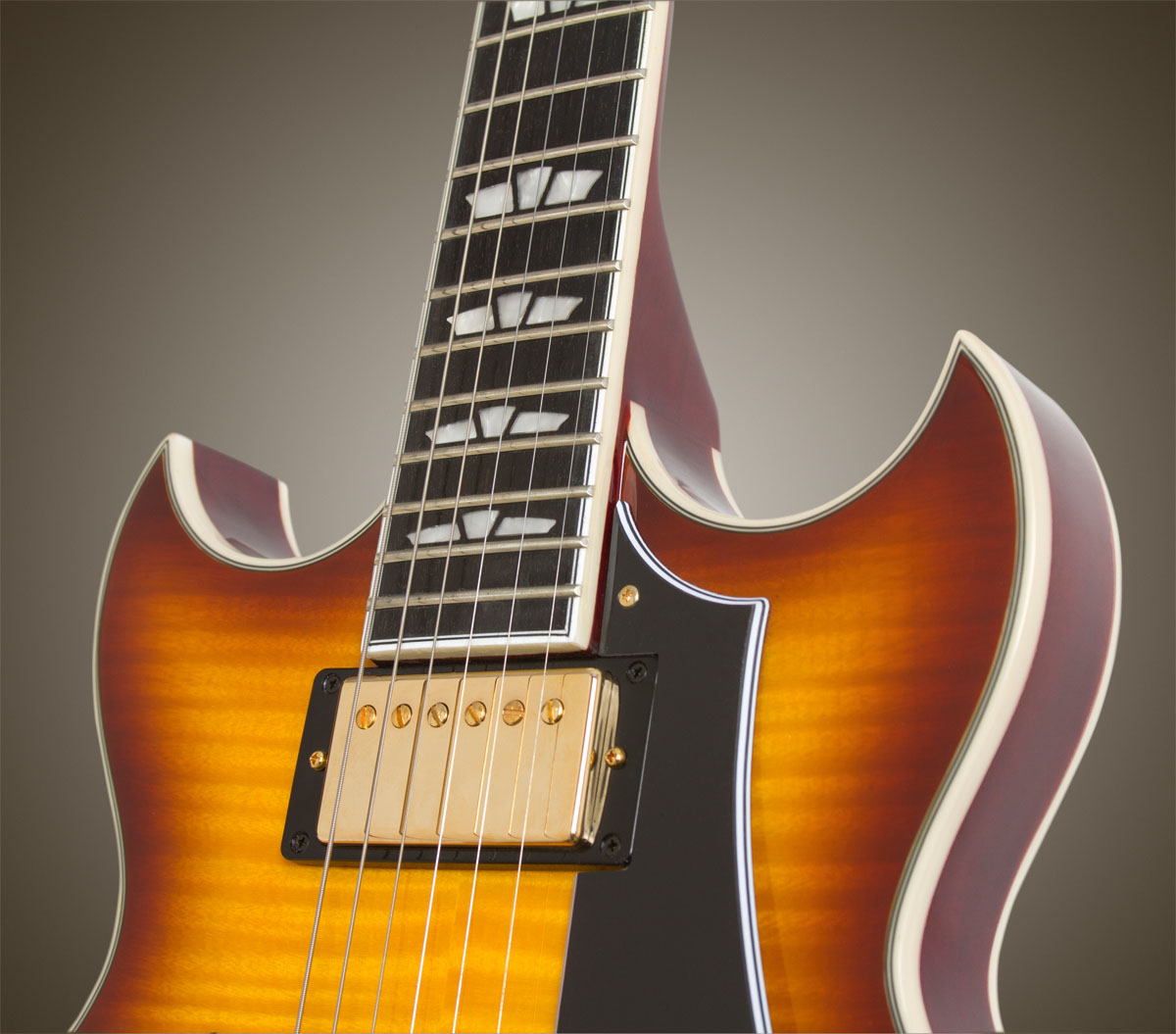
This Epiphone model has a pair of Gibson USA ’57 Classic humbuckers with gold-plated covers and an inlaid ebony fretboard with three-ply (w/b/w) binding.
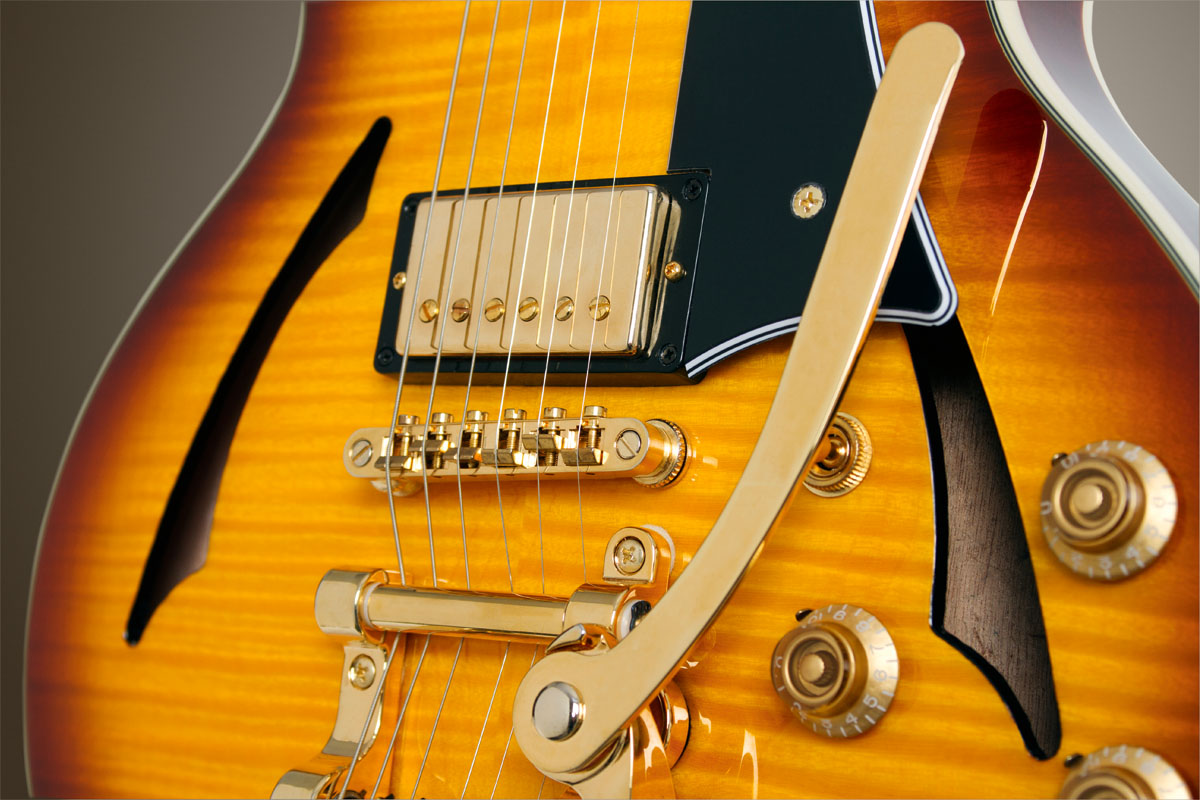
Gold-plated ABR-1 tune-o-matic bridge, Bigsby B70 vibrato, and three-way selector switch with individual pickup volume and tone controls.
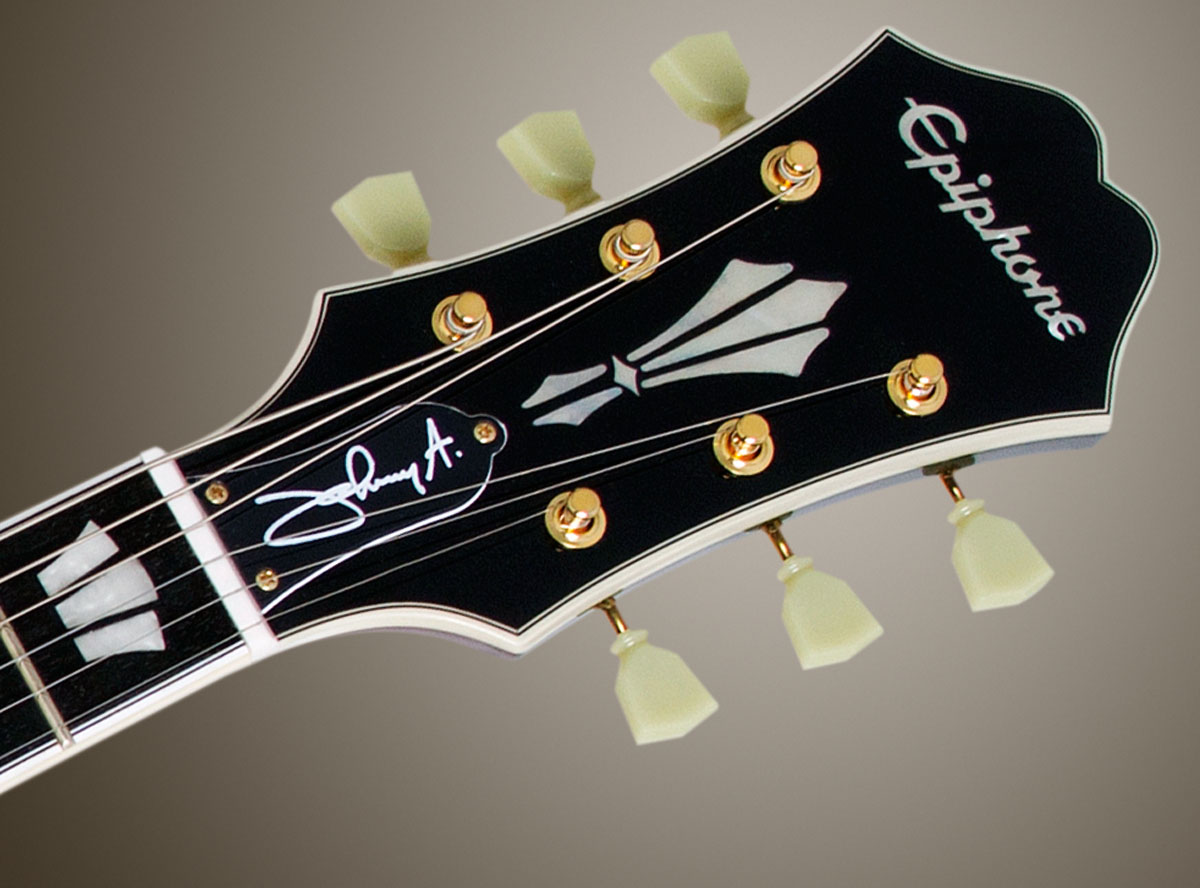
The headstock has the classic Epiphone elongated profile and gold-plated Epiphone Deluxe 18:1 ratio tuners with tulip buttons.
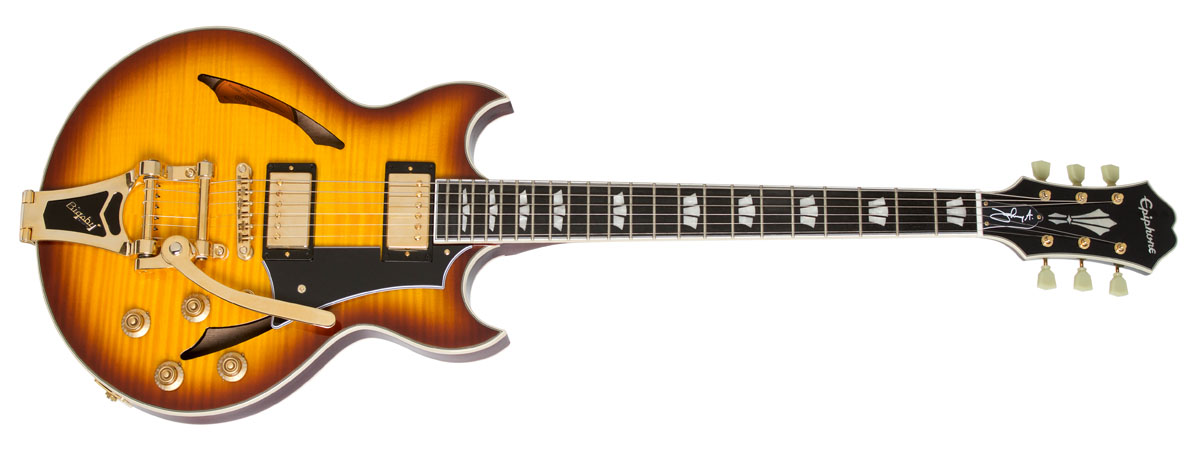
The Epiphone Johnny A. Custom was launched in 2017 featuring a mahogany body with figured maple top and 25.5-inch scale length mahogany neck with ebony fretboard.
Your 1999 solo debut, Sometime Tuesday Morning, got plenty of radio play before being re-released in 2001 on Steve Vai’s Favoured Nations label…
“Right. I recorded it and put it out independently. I was actually selling it pretty good on my own. It was getting a lot of radio airplay in the New England area, and because it was making so much noise, labels were approaching me.
“I got approached by a lot of labels back then, but I ended up going with Steve Vai’s Favored Nations and we did really well. The first single off that record [Oh Yeah] ended up being No 1 on the AAA [Adult Album Alternative radio format] charts across the country. The album went on to sell over 100,000 copies.”
I still try to get an analogue feel and tone even if I’m using digital gear. I still hear with analogue ears and feel with an analogue soul
Was Sometime Tuesday Morning a turning point for you?
“I think there was an element of surprise when people heard it, because people didn’t know me for that type of guitar playing back then and I’d been working really hard to define a different-sounding record. I had never really intended to make that album. I had just left Peter Wolf’s band after about eight or nine years, and I had a family to support.
“It was about putting together a little trio so that I could go and work and make money, but I couldn’t sing because I’d lost my singing voice due to a really bad bronchial infection and a severe case of laryngitis. So I just decided to focus on being an instrumental guitarist. I was never an instrumentalist before that, I just developed it.”
How did the Gibson Johnny A. signature models come about?
“Gibson was basically my voice. My guitar was my voice, in the tradition of guitarists from the 50s and 60s like Johnny Smith, or any other guitarists playing vocal songs instrumentally. So when the Sometime Tuesday Morning album started to get all that success, one thing led to another and we collaborated.
“The idea came out of the need for one guitar to cover a lot of bases. Most of that first record was recorded with an ES-295, but I also used Les Pauls, Firebirds, 335s and an L-5. Playing live, I was switching between a 295, a 335 and a Les Paul, but I really don’t like playing different guitars live – I’d rather just play one guitar.
“Gibson originally approached me at the Summer NAMM in 2002. They asked me how my Les Pauls were working out and I said, ‘I really can’t fault the design, but I’m missing the hollow tone I got from using a hollowbody.
“I wish there was something we could do to kind of get me everything that the Les Paul’s getting me but with a hollow tone.’ So they said they’d be interested in working with me and developing something that would fit that niche.”
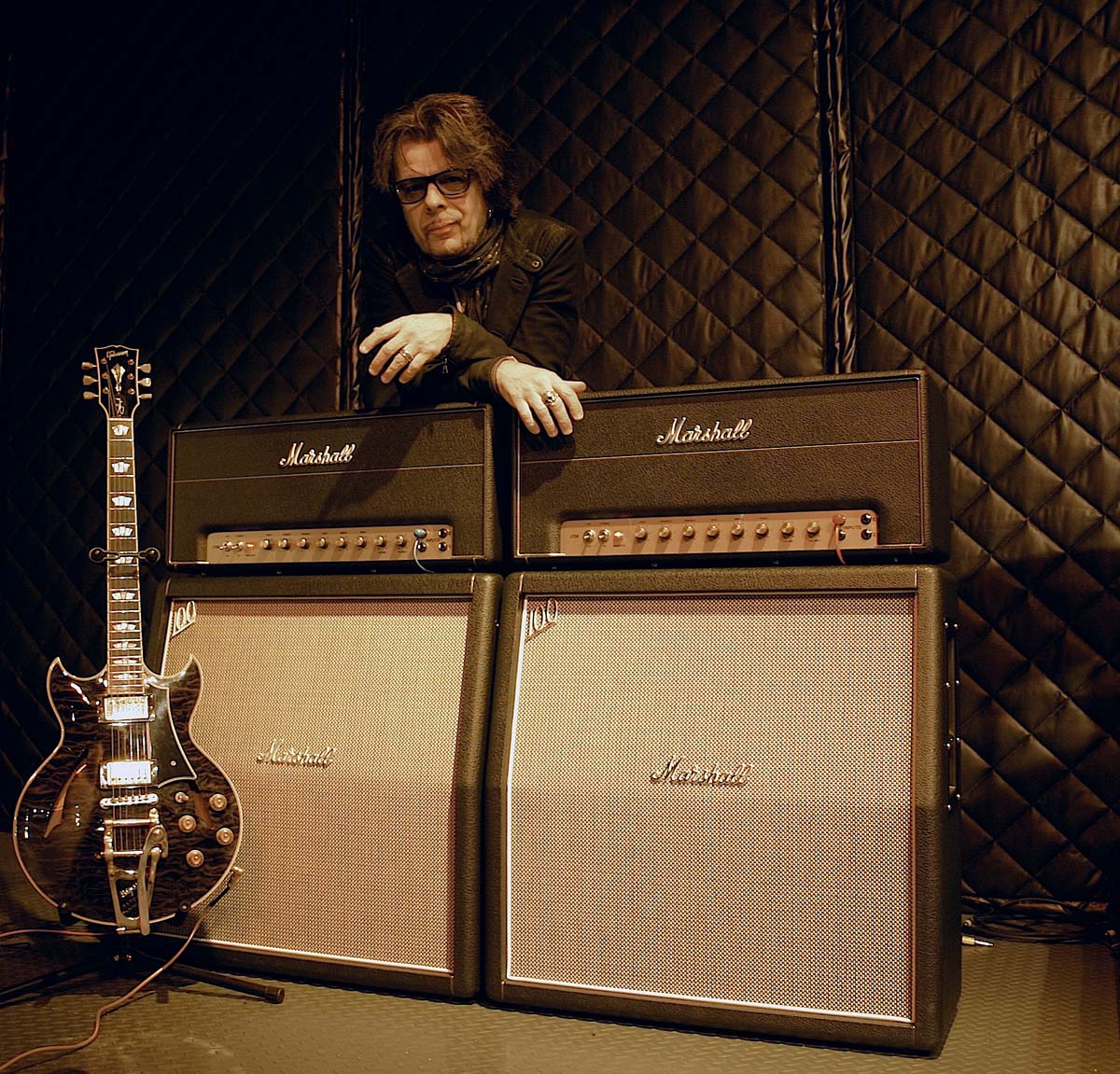
Evidently, you’ll go to great lengths to find the right tone. How did you nail The Yardbirds sound?
“I was looking for a MKI Tone Bender, because that’s what those early Yardbirds records were. Jeff Beck used them pre-Jimmy Page. Jimmy used the later one [the MKII Tone Bender]. So I called up Ant at Macari’s and he said, ‘We are going to do a series of MKIs, but we don’t have any ready yet.’ I said, ‘Well, we have rehearsals in three weeks and then I go on the road. Is there any way you can get me a prototype?’
“So he had David Main [of D*A*M Stompboxes] do a series of MKIs and they made me the prototype. I have the very first one. Which was interesting because Ant [Macari] told me the very first MKI made went to Jeff Beck for The Yardbirds. And 50 years later, the very first prototype that David Main made of the MKI went to me for The Yardbirds!”
If I’m standing in front of a regular amp, or playing a Kemper through powered cabinets, I think I could probably tell the difference
What amp did you use for The Yardbirds gig?
“For The Yardbirds, you’ve really got to use an AC30. I tried using Marshalls in that band and it really doesn’t work. There’s a certain aggressiveness and in-your-face thing that happens with an AC30, and it works for that band.
“But my preference for amplifiers has always been Marshalls, particularly JTM45s – I have four of the hand-wired JTM45s. I’m partial to a Marshall! I think their clean sounds are very much under-discovered. Every track on all of my records was recorded with a 30th Anniversary Marshall 6100. I have nine blue ones from 1992.”
Your current rig is another thing altogether...
“I really love vintage tones, but on this solo gig I’m doing now, I’m using a Fractal Axe-Fx III. It works perfect for that. I’ve also just picked up a Kemper and I’ve been messing around with that. The Fractal doesn’t feel like an amp, but it’s the perfect choice for what I’m doing with the solo looping gig, because it doesn’t really sag and it keeps all the loops articulate.
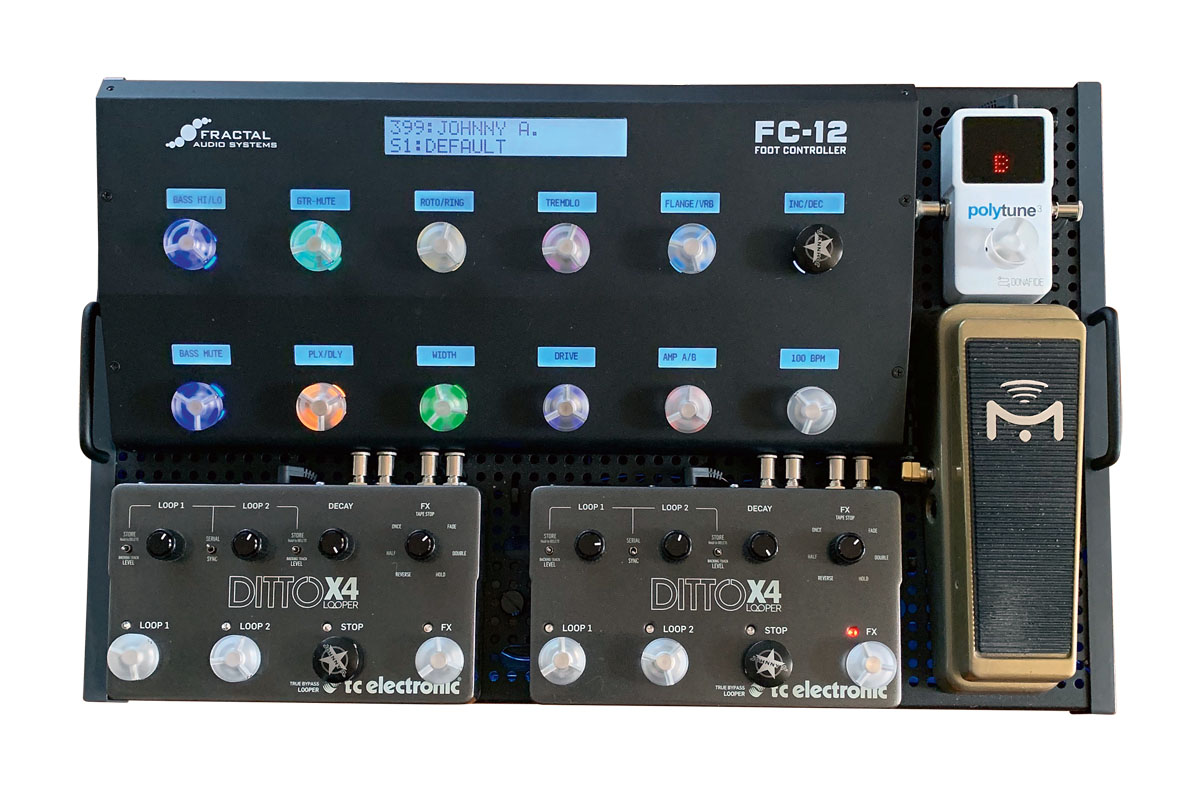
His one-man ’board includes TC Electronic Ditto X4s, Fractal’s FC-12, Mission expression pedal, and TC PolyTune 3.
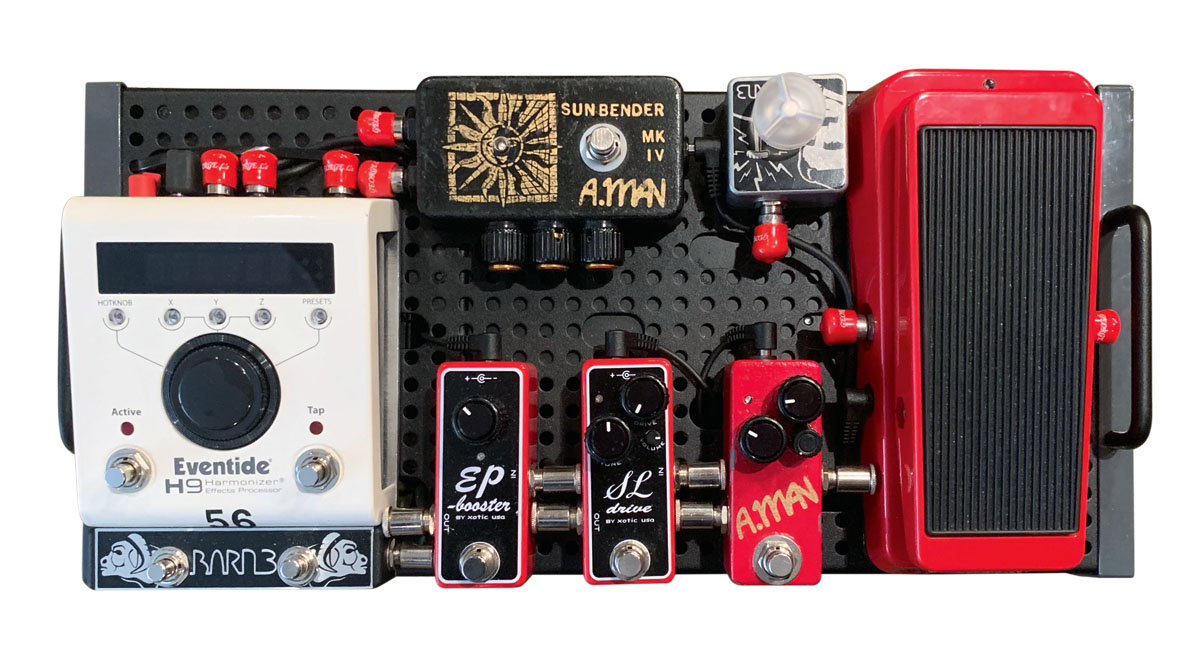
Johnny A.’s pedalboard for The Yardbirds included an Analog Man Sun Bender MK-IV and a custom-built reverse-engineered David Main MKI Tone Bender; an Xotic wah, SL Drive and EP Booster; and a Barn3 OX9-enhanced Eventide H9.
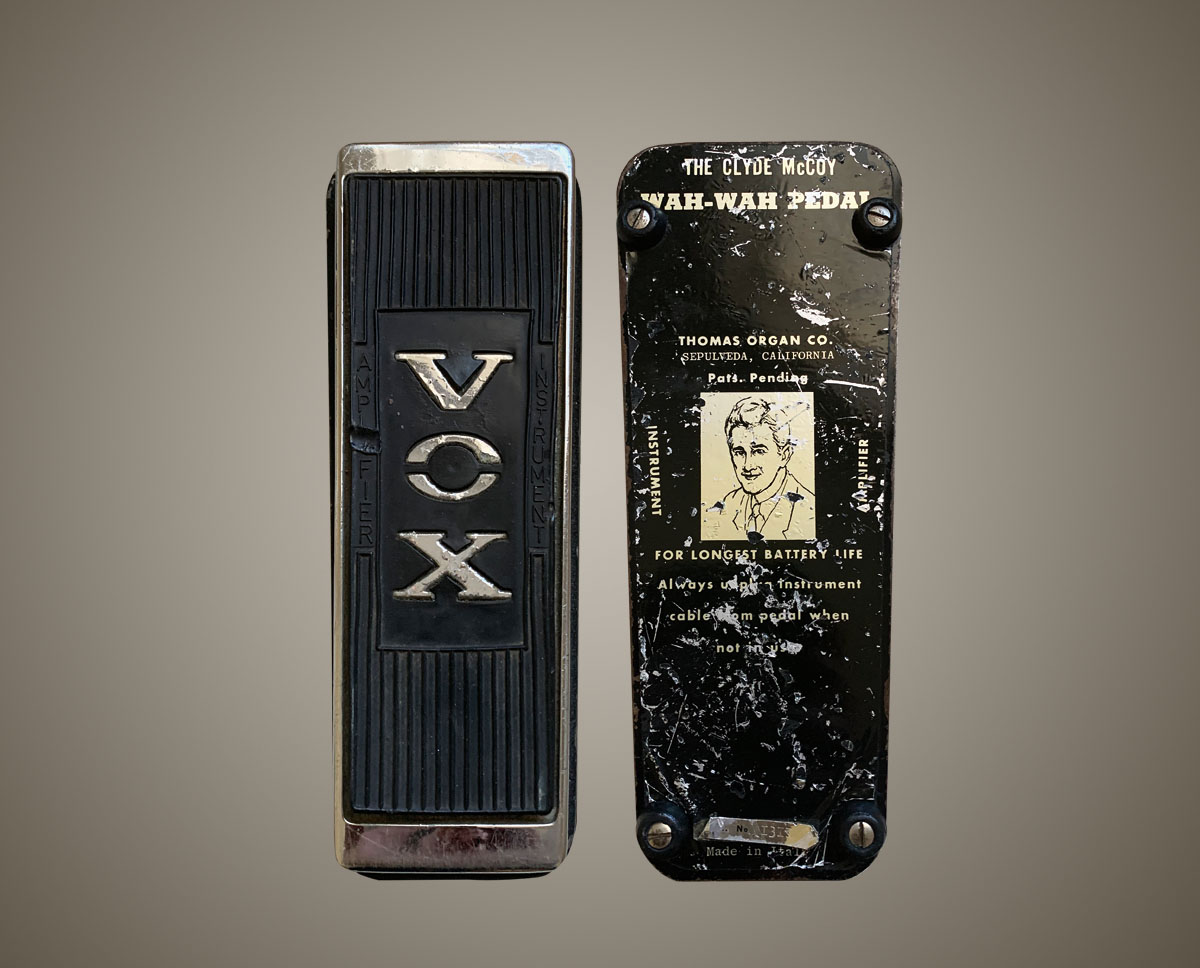
Johnny A. bought his Vox Clyde McCoy Wah-Wah in 1967, the same week that Are You Experienced was released.
“The Kemper gives you more of an amp feel, no doubt about it. These days, I think it would be very hard for anybody to tell the difference between a mic’d amp and a Kemper by listening to a recording. But if I’m standing in front of a regular amp, or playing a Kemper through powered cabinets, I think I could probably tell the difference.
“At the end of the day, I still try to get an analogue feel and tone even if I’m using digital gear. I still hear with analogue ears and feel with an analogue soul. Those are the sounds I love. I’m not a vintage snob.
“I love vintage guitars and amps, but I love new guitars and new amps, too, if they’re good. The bottom line is: does it sound good? And who really cares what the tool is to get you the end result? In the end: do I like it or not? Does it work or not?”
Rod Brakes is a music journalist with an expertise in guitars. Having spent many years at the coalface as a guitar dealer and tech, Rod's more recent work as a writer covering artists, industry pros and gear includes contributions for leading publications and websites such as Guitarist, Total Guitar, Guitar World, Guitar Player and MusicRadar in addition to specialist music books, blogs and social media. He is also a lifelong musician.
“There’d been three-minute solos, which were just ridiculous – and knackering to play live!” Stoner-doom merchants Sergeant Thunderhoof may have toned down the self-indulgence, but their 10-minute epics still get medieval on your eardrums
“There’s a slight latency in there. You can’t be super-accurate”: Yngwie Malmsteen names the guitar picks that don’t work for shred


![A black-and-white action shot of Sergeant Thunderhoof perform live: [from left] Mark Sayer, Dan Flitcroft, Jim Camp and Josh Gallop](https://cdn.mos.cms.futurecdn.net/am3UhJbsxAE239XRRZ8zC8.jpg)








